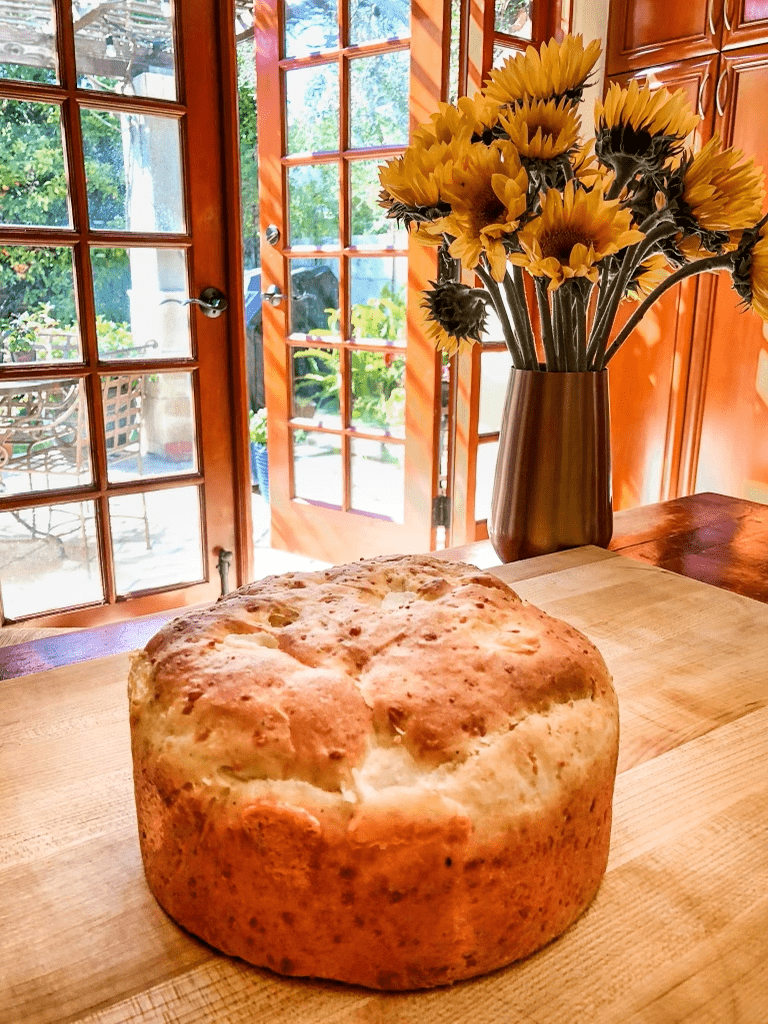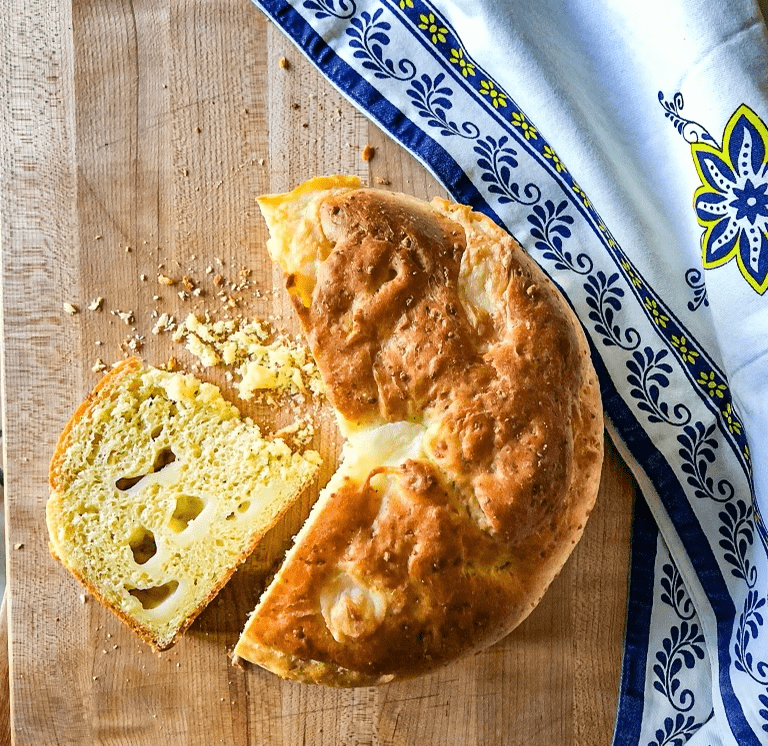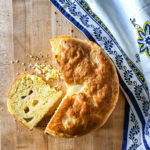
My sister Michele and I have been on a sensory journey lately–one of food smells and tastes that invoke fond recollections. Looking at old photos doesn’t even come close. Especially now with the pandemic forcing a long period without family get-togethers and holiday celebrations, reliving favorite memories through our favorite foods gives us hope for making new memories filled with family and food in the not-too-distant future.
Recently we posted about our Mom’s comforting winter Italian Wedding Soup; Chicken with Wine, which can fill a room with its irresistible aroma; and the non-Italian–but everyone’s favorite–Molasses Crumb Cake. As the aromas of these dishes fill our kitchens, they also fill our hearts with nostalgia. Powerful emotions come with the flood of memories: some of warm supportive family gatherings around a big table, others of big fights and loud arguments (about what, exactly, we can’t remember).
All these smells and tastes didn’t fill just our house. We were lucky enough when we were young children to have our grandparents as well as our Aunts Annie and Mary living in the original family home just a few blocks away. Michele and I both spent a lot of time there as kids, playing and hanging out after school. Our aunts Mary and Annie were really second parents for us. Saturday road trips in Aunt Annie’s Monte Carlo the Land of Make Believe and late night coffee chats with Aunt Mary are still strong memories with both of us.
My Aunt Annie by her own admission couldn’t boil water, but my Aunt Mary was a wonderful cook. I so clearly remember the taste of my Aunt Mary’s mouth-watering Crescia al Formaggio (or as we knew it, just crescia), which she made around Easter. This savory bread gets its name from the Italian verb crescere – to rise. Its name is a pun on both the effect of yeast in the bread and the resurrection of Christ.

I remember the smell of this bread baking but even more the taste, especially when toasted and spread with a little butter. Its combination of cheeses and black pepper was a constant at breakfast or for snacks during the Easter season. My dad used to soak up the leftover spaghetti sauce on his plate with it.

This recipe comes straight from the Marche region of Italy where our paternal grandfather Giuseppe was born. It uses my Aunt Mary’s recipe with some tweaks from my Italian cousin Massimo Becci’s wife Maria; they still live in the very house where our grandfather and his brother, Massimo’s grandfather, grew up. You can read some of this backstory in a previous post.
This recipe is all about the cheese, so this is the time to spring for good-quality cheeses: Parmigiano-Reggiano and Pecorino Romano, as well as Asiago or Fontina melting cheeses. Good-quality olive oil is also important.
In trying different baking recipes recently, I came across an approach from Jessica Gavin for using your oven as a makeshift proofing box. I quite like this idea, as it will speed up the proofing time considerably. Just check the dough occasionally so you don’t shoot past the doubled size. I’ve tried this several times for different baking recipes and it works great!
Try this recipe and enjoy crescia during this Easter season, for breakfast or for an afternoon snack. It’s an invitation to embark on your own sensory journey!
Print
Crescia al Formaggio
- Yield: 1 loaf 1x
Description
The yeast, cheese and flour ingredients below are given by weight, the preferred measurement for baking. Pull out your trusty scale!
Ingredients
- 18 g fresh yeast — or — 7 g instant yeast (about 2 tsps)
- ¼ cup milk
- 1 tsp sugar
- 5 large eggs, at room temperature
- ½ cup olive oil
- 150 g grated Parmesan cheese
- 50 g grated Pecorino Romano
- 1 teaspoon ground black pepper
- ½ teaspoon salt
- 500 g flour
- 150 g mild melting cheese such as Asiago, Fontina, Gruyère, or Swiss cheese cut into ½-inch cubes
Instructions
- Prepare a 8- or 9-inch cake pan or springform pan by lightly greasing the inside with butter, olive oil or olive oil spray.
- In a small bowl, mix the yeast and the sugar. If using fresh yeast, make a paste with the yeast and sugar.
- Heat the milk in a small pot on the stove to lukewarm (about 100℉-110℉) and stir into the yeast to dissolve. Leave the mixture for about 10 minutes until it’s bubbly and foamy (this step isn’t strictly necessary for instant yeast but it will make sure it’s still alive and viable).
- In a large mixing bowl, add the eggs and whisk until smooth.
- Add the yeast mixture and olive oil and whisk until combined and emulsified.
- Now switching to a wooden or silicon spoon, add about 1/3 of the flour, Parmesan and Pecorino cheese, salt and pepper and mix into the egg mixture until completely combined.
- Slowly add the remaining flour and mix to combine as completely as you can.
- Scrape out the dough and any remaining bits of flour onto a wooden board and mix with your hands until completely combined. Knead the dough for 5-10 minutes until the dough is smooth.
- Place the dough in an oiled bowl, cover loosely with plastic wrap and place in a warm area to rise until doubled in size, about 1-2 hours (see note about using your oven as a proofing box).
- Remove the risen dough and place on the wooden board. Add the cubed melting cheese pushing the cheese into the dough.
- Gently form the dough back into a ball and place in the cooking pan. Cover loosely with plastic wrap and place in a warm area to rise until doubled in size, about 1-2 hours (again see note about using your oven as a proofing box). Remove the plastic wrap.
- Preheat oven to 350-degrees and place a sheet pan below a springform pan (this dough has a lot of oil in it and it can leak). Bake the bread until golden brown on top, about 30 minutes. If the bread is browning too quickly, cover with aluminum foil.
- Remove from oven and let cool for 5 minutes.
- Remove from the baking pan and place on a wire rack to cool completely.
- Serve in wedge slices with a little butter, or just as is!
Notes
See Jessica Gavin’s article for using your oven as a makeshift proofing box.
Equipment:
- 8- or 9-inch cake pan or springform pan
- Sheet pan

Joe: You need to translate grams into regular measurements.
Thank you.
Thanks for your comment. I’ve been baking strictly by weight lately. It gives a much more consistent result. In a pinch, here’s the rough conversion of those ingredients:
– Instant yeast, 2 1/2 tsps
– Flour, 4 cups
– Grated cheeses, 1 cup
– Melting cheese, 1/2 lb
Hopefully that helps. Thanks. Joe
Hi joe, What I’ve learned as a passionate home baker is that you should invest in a scale. I do live in the states and do use both. Recipes from other countries always have measurements in grams etc. That is a more accurate measurement. Home baker or not, get yourself a scale. You’ll be amazed.
Thank you for your recipes. I really enjoy them. I thought I read somewhere in all my baking crazy, lol, that the famous French kings and queens had Italian bakers! I’m hoping that was true as I am Italian myself and live for butter, flour, sugar and eggs!
Can’t wait to try any and all of your recipes.
ha, ha… sorry for the delay.. this is the way Americans like recipes written.. every detail spelled out! Joe
My dad made this for us. He didn’t use milk and never wrote the recipe down. It seemed to be about texture and feel to him.
This is great.
Thanks. I have so many childhood memories for this dish. Also, the milk really isn’t needed if using instant yeast. It just helps when proofing dry active yeast. Thanks. Joe
Hi Joe. Wondering if I can use a dough hook versus kneading the dough myself. My parents were also from Pesaro and I have fond memories of waking up to the smell of this amazing bread.
Hi Pat: I too remember those smells as a child. My 2nd cousins daughter currently lives in Pesaro. It’s a beautiful seaside town.
I think using a dough hook would work great. I would probably use a lower speed as this isn’t a very gluten-y bread. Let me know how it turns out.
Joe
Going to try this out. My maternal grandparents are Marchegian and I’ve only ever had it at their house due to my mom not liking “stinky” cheeses. Want to keep the tradition going!
Wow. Excited to try this. My mother and grandmother made this bread all the time. Such a part of my childhood! The family would finish the loaf while it was still hot – with their homemade butter. Neither wrote down the recipe, and I’ve tried to wing it to no avail. This seems so similar. They always made theirs in bundt pans! Thanks for this!
We’re so happy you came across our recipe. I so remember the smell of Crescia at Easter. It’s still my favorite. I hope your bake of this is successful! I really like the taste with fresh (cake) yeast if you can find it. Thanks. Joe